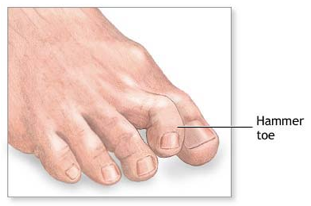


HAMMER TOE A hammer toe is a deformity of the lesser toes (second, third, fourth or fifth toes). The toe is bent to look like a hammer. A hammer toe can be flexible (able to straigten out by examiner) or rigid.
TREATMENT OPTIONS Nonsurgical Treatment: The most common treatment is to wear more comfortable shoes. When choosing a shoe, make sure the toe area is high and broad and has enough room for hammer toes. Other types of treatment are products designed to relieve hammer toes, such as hammer toe crests and hammer toe splints. These devices will help hold down the hammer toe and provide relief to the forefoot. Gel toe shields and gel toe caps can also be used. Gel toe shields and toe caps will help eliminate friction between the shoe and the toe, while providing comfort and lubrication. Surgical Treatment: The indication for surgical treatment of hammertoe deformity is disabling pain that does not improve with adequate nonoperative treatment, including taping (for flexible deformity) and the use of accommodative footwear featuring a toe box of adequate depth (for fixed deformity). Surgical correction of an asymptomatic hammertoe is indicated at the time of hallux valgus correction, to minimize the likelihood of recurrent hammertoe. To find out more information on Hammer Toes, please visit the Orthopaedic connection website of American Academy of Orthopaedic Surgeons.
|
|---|
 Hammer toe is most often caused by wearing compressive shoes. It might also be caused by the pressure from a bunion. High heeled shoes are can also cause hammer toe. The reason for this is that the toes are not only bunched up, but the weight of the
Hammer toe is most often caused by wearing compressive shoes. It might also be caused by the pressure from a bunion. High heeled shoes are can also cause hammer toe. The reason for this is that the toes are not only bunched up, but the weight of the